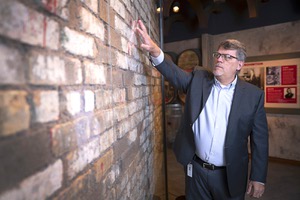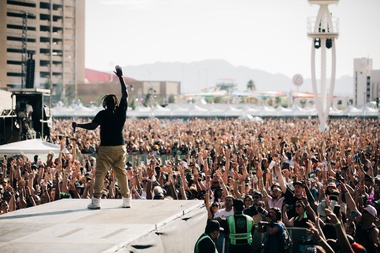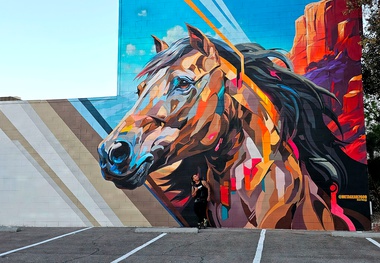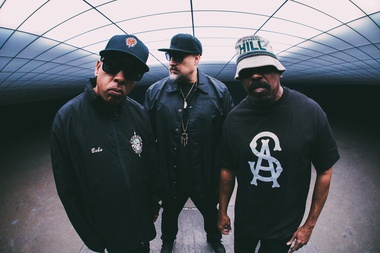One does not simply visit the Mob Museum casually. It’s an experience reserved for several hours and possibly even days, according to museum President and CEO Jonathan Ullman. “We knew we wanted it to be rich,” he says. “We didn’t want to distill it down to where you go through it once and it takes you 60 to 90 minutes.”
Thousands descend upon the award-winning destination annually to learn more about Las Vegas’ historical mob era. In response, the museum vies to stay relevant for every age and demographic. “So by nature,” Ullman says, “it’s got to continue to evolve.”
Since the museum opened in 2012, it has undergone renovations, unveiled more exhibits, received national recognition and steadfastly served the Las Vegas community through educational outreach impacting 25,000 students and seniors. As the museum’s 10-year anniversary approaches on February 14, the Weekly chatted with Ullman about its growth, his favorite exhibits and society’s persistent fascination with the mob.
The Mob Museum surpassed 100,000 visitors in its first year. It recently welcomed its 3 millionth. What has it been like to watch the museum flourish over a decade? It’s enormously gratifying. We’ve come a long way, and I can’t underscore how many hands have been in this process. … It started with the City of Las Vegas, under Mayor Oscar Goodman. It was really first his vision about recognizing the opportunity to get this building. It’s a former federal building, former U.S. box office and federal courthouse, which is part of why it’s so relevant to us, specifically because of the courtroom and events that took place in the courtroom.
It’s also a wonderful landmark. … Las Vegas isn’t great about preserving old buildings; they typically blow them up. So here you have one of the best examples of neoclassical architecture you will find anywhere in Las Vegas beautifully restored. …
What Oscar and the other staff at the city recognized back then was, this was a real opportunity to revitalize Downtown by doing something that would attract visitors and new audiences, and doing something that makes sense for us, and is unique and enticing. … I’m not certain you can point to a more successful public-private endeavor than what we’ve had here. The city did much of the initial heavy lifting, but then a group of community members who formed the board, incorporated the organization and basically created the museum, took it forward and created something magical.
A decade in, why do you think the museum still resonates with people? Part of it is that you can’t tell American history, you can’t tell Las Vegas history, without talking about organized crime and law. It’s just interwoven into our story. It’s also for the same reasons that this topic is so compelling in popular culture. It’s fascinating to people. They love to hear the stories of good versus evil. It’s cops and robbers. And in many respects, the real stories are as fascinating as anything that you could ever concoct for movies or television. You’ve got tons of appeal.
The Mob Museum boasts four floors of historical artifacts. Which exhibits are your personal favorites and why? Some of the exhibits we’ve had from day one I still love, like the wiretap interactives. How cool is it to be able to listen to recordings of Kansas City crime bosses, or John Gotti? Recordings that were used as evidence in prosecutions. I love that. I love the courtroom program. It tells the story of the Kefauver committee trials, one of the hearings that took place in our building, and that’s such an amazing room to be in. It’s been restored as it was, and it’s awesome. …
We also have the wall from the St. Valentine’s Day Massacre, which was such an extraordinarily pivotal event when you talk about the history of organized crime and law enforcement in the Prohibition era and what really raised a very broad awareness of how bad this activity and bad these people were, Al Capone in particular. … Adjacent to the wall, we have all the ballistic evidence that was gathered from the scene of that crime. … It was one of the first times ever that they were able to use forensic science to link a weapon to a crime. …
And I think that’s one of the really wonderful sub-themes of the museum. … As the criminals are doing these different rackets, how does law enforcement evolve in how they pursue the criminals and prosecute the crimes? … We have this evolution or progression, as opposed to just thinking about it in terms of discrete time periods and events. There’s a thread that flows through it. That’s really fascinating.
The museum has hosted more than 300 public programs, where experts have discussed other crime topics, unrelated to the mob. What was behind that shift in focus? Our mission is fundamentally about organized crime and its impact on society. But there is, particularly when you talk about Las Vegas history, a lot of ancillary history, or history that’s interwoven that is still relevant. When you talk about law enforcement and some of these other topics, the methods [they] used to pursue criminals and investigate cases aren’t necessarily limited to organized crime. … It’s both about us being a museum about law enforcement and being a museum in and of itself. Serving our community and being a place where people can gather and better understand different topics, that motivates us to put on programs. And you can have a little more latitude with the types of programs you do than, say, permanent exhibitions.
We’ll do programs like community safety forums. We’ll do programs about forensic science. We’ll do programs that are historical in nature. … The programming can really span a gamut of things, particularly when you get into contemporary issues—stuff about police reform or things that might be on a referendum for an upcoming election. How [to] help people understand issues so they can be more informed citizens and make better decisions about the world they live in.
10th Anniversary Celebrations
The Story of the Mob Museum: Celebrating Its Past, Charting Its Future February 10, 7 p.m.
Free Admission to the Mob Museum February 14, 9 a.m.-9 p.m. (with Nevada ID)
The Massacre Tommy Guns: A Special Display of Historic Firearms February 14, 9 a.m.-9 p.m.
Limited Edition Moonshine February 14, noon-6 p.m., the Underground Speakeasy
Undercover of the Night Gala February 17, 7 p.m.
Rose and Lavender Aviation Anniversary Cocktail Throughout February, the Underground Speakeasy
Click HERE to subscribe for free to the Weekly Fix, the digital edition of Las Vegas Weekly! Stay up to date with the latest on Las Vegas concerts, shows, restaurants, bars and more, sent directly to your inbox!








